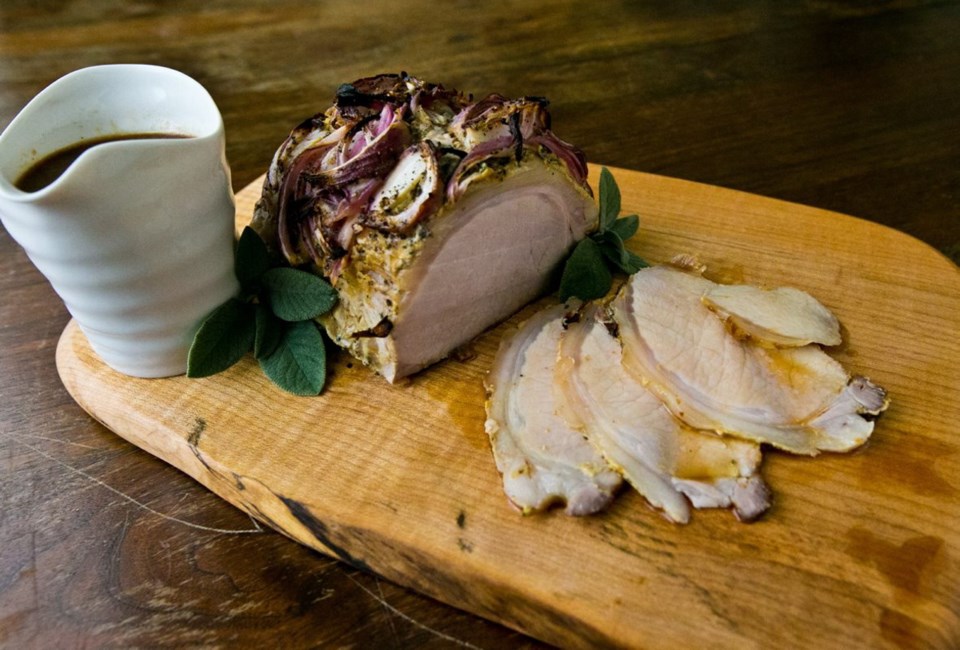 Dear Eric: Can you help me with roasting boneless sirloin pork roasts and pork loin rib roasts? Sometimes, mine turn out really tender, other times they are tough. I use my convection oven and put seasonings on the roast and some olive oil. I also make sure my meat thermometer is set for 160 F.
Dear Eric: Can you help me with roasting boneless sirloin pork roasts and pork loin rib roasts? Sometimes, mine turn out really tender, other times they are tough. I use my convection oven and put seasonings on the roast and some olive oil. I also make sure my meat thermometer is set for 160 F.
Sylvia
Dear Sylvia: In a story I wrote on cooking pork chops a few years ago, I noted that in an effort to make pork “the other white meat,” over the years, hogs have been bred to yield leaner meat. According to the Canadian Pork Council (cpc-ccp.com), all raw, fresh pork cuts, except ribs, when trimmed of visible fat, now qualify as lean meat under Health Canada guidelines.
Because of that, pork sold at most major supermarkets is now so lean that unlike a premium beef strip loin steak, it’s no longer richly marbled with fat. When that steak cooks, the fat melts and permeates the meat, making it juicy and aiding tenderness, even when very well done, a state of doneness that can turn a pork roast chewy and tough.
That is particularly true for roasts cut from the very lean loin, a cut of meat that runs along the top back of the animal, and the sirloin, which is cut from end of the loin near the hip. But many are compelled to cook that pork well-done for food safety. The origins of that belief derive from trichinosis, a disease caused by a parasite.
However, the Canadian Pork Producers website, putporkonyourfork.com, says trichinosis is no longer a health risk, and 15 years ago it was removed from national surveillance by the Public Health Agency of Canada. And even if trichinosis was still a concern, the parasite causing it is destroyed at 137 F, well below pork’s suggested cooking temperature of 160 F.
Because of that, the Canadian Pork Producers says a touch of pink in pork is both safe and desirable, especially for lean loin cuts. The exception is ground pork and sausage, which, like all ground meats, must be thoroughly cooked.
Canadian Pork Producers says pork roasts, including tenderloin, can actually be removed from the oven when the internal temperature reaches 155 F. The meat should then be covered loosely with aluminum foil and allowed to rest 10 to 15 minutes. During the resting, the meat will continue to cook and the temperature will rise to the recommended 160 F.
These days, though, I tend to take the meat out when it’s at 150 F, as after resting it always does seem to get up to that 160 F mark. And that resting is important, as it allows the meat’s juices to set and not run out as would occur if you sliced the meat seconds after cooking. That, too, could cause it to become dryer and tougher.
Sylvia noted that she uses convection heat to roast her pork. A fan circulating heat around the oven achieves convection heat, and that moving hot air cooks food up to 25 per cent faster than regular heat. For example, a pork roast that takes 100 minutes to roast using regular heat might be done in 75 minutes using convection.
With pork loin or sirloin, though, that quicker cooking and hot air blowing around the lean meat may actually cause the roast to be dryer in texture once cooked, which is why I think regular oven heat is a better option for those cuts.
When buying pork loin and sirloin roasts from the supermarket, I choose those that have a nice “fat cap,” a layer of fat on the surface of the meat. That’s because as the meat cooks, that fat melts and self-bastes the meat, adding juiciness.
I also like to let my roast sit at room temperature at least 60 minutes before cooking. If icy cold, it won’t cook evenly, with outer parts being cooked well before the middle, which in turn can cause those sections of meat to be dryer and tougher.
Lastly, if you want to try that old-fashioned pork that was fattier, richer and full of flavour, there are local farmers raising those types of animals again, such as Berkshire pigs. Examples are Sloping Hill Farm in Qualicum Beach and Stillmeadow Farm and Parry Bay Sheep Farm in Metchosin. If you Google those farms you’ll learn where you can purchase their pork.
Note: Beyond the roasting tips above, two other ways to increase the tenderness and juiciness of lean pork cuts are to marinate or brine them. In next Sunday’s column, I’ll tell you why and how.
Roast Pork with Mustard, Sage and Onions
This small roast serves four and cooks relatively quickly, making it an option for a mid-week supper. Be sure to use an instant-read thermometer to gauge the doneness of the pork.
Preparation time: 10 minutes
Cooking time: About 50 to 60 minutes
Makes: Four servings
1 3⁄4 lb. boneless pork loin or sirloin roast
2 Tbsp Dijon mustard
1 Tbsp chopped fresh sage, or 1 tsp dried sage leaves
• salt and freshly ground black pepper to taste
1⁄2 small to medium red or yellow onion, very thinly sliced
1 3⁄4 cups chicken stock
3 Tbsp. all-purpose flour mixed with 1/2 cup chicken stock
Preheat the oven to 350 F. Place the pork, fat side up, in a roasting pan. Combine the mustard and sage in small bowl. Brush the top and sides of the roast with the mustard mixture; sprinkle with salt and pepper. Top the mustard-coated parts of the roast with the onions, pressing them on to help them adhere.
Roast the pork for 50 to 60 minutes, or until the centre of the roast reaches 150 F to 155 F on an instant-read meat thermometer. Transfer the roast to a plate, tent with foil and let rest for 10 minutes.
While the meat is resting, remove any fat from the pan drippings and then set the pan on the stovetop over medium-high heat. Add the 13⁄4 cups of stock. Bring this to a boil while scraping the bottom of the pan to dislodge any brown bits. Slowly whisk in the flour/stock mixture. Simmer a few minutes, until the gravy has thickened, and then season with salt and pepper to taste. Thinly slice the roast and serve the gravy alongside.
Eric Akis is the author of The Great Rotisserie Chicken Cookbook (Appetite by Random House). His columns appear in the Life section Wednesday and Sunday.



